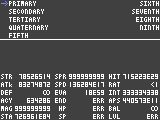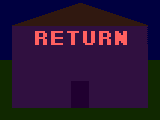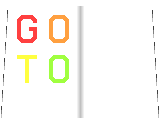
What is the history of the Status System?
1. Status System's birth
My Status System has been around since early January of 1996. At that time, it was so confusing, that it was very difficult to understand it, that not even I could. An evasion rate of 65 meant nothing when first created. Today it means that you have a 6.5% chance of evading an attack whose hitting accuracy or throwing accuracy was 100% on a still target 10 meters away.
At first, there were only 5 stats, ATK (attack), DEF (defense), ACY (accuracy), MAG (magic), and EVA (evasion rate), and without the 3-letter abbreviations. ATK was your physical strength, DEF was your defenses, in which, at the time, had undefined* units of measurement, ACY was how accurate you are with shooting baskets and your IQ, MAG was your strength of using special abilities, and EVA was how well you can dodge an attack.
2. 1st and 2nd major changes
After about a year, in 1997, things started to change. At first, four more stats were added to the list: ATK%, DEF%, ACY%, and EVA%. They just simply meant how much of each you use on average. They also led to the first defined units of measurement: percentages. This minor change was left alone for a long while.
Then, an idea came to me which led to something interesting. I thought of inventing things. My Status System seemed like an invention to me, so I started figuring ways to make it easier to understand, as well as more accurate. In June of 1997, I started writing stories, with a simple 16-page story. Today, my longest story is as long as 400 written pages [includes images and page breaks after an act ends]. My first story I wrote was called "the Story of the Wonderful Adventure". It didn't have much to it, so I decided to lengthen it to a novelette** size. While I wrote my story, I was also editting my Status System with it, because my story used the 1997 Status System. As I came to finishing my story in January or February of 1998, I started typing it. I write stories in the format of a play or script. After I finished typing it, I gave it out to others, but soon started a second episode of it.
My second episode was written completely, but never typed out, except the first half of the first act. It also led to slight changes to my Status System, like the birth of the secondary Status of other features such as pulse, blood pressure, luck, height, weight, etc. It was easy to understand since everyone uses most of them. Luck was like another one, but used undefined units of measurement. My second episode was soon completed, and I got into a third. The third episode never got completed due to the Status System finally evolving into something worthwhile.
3. The modern version was born!
During 1999 and 2000, my Status System all of a sudden took off in a rocket [I think it was awaiting a launch or something :)]! It started to change very quickly. It changed so fast that the next day, what ever I wrote in the story that related to the Status System was completely outdated and inaccurate.
I decided to rearrange and modify every stat to have defined units of measurement based on the metric system. At the start of the rapid reorganization, it evolved into STR (strength), ATK, DEF, ACY, MAG, SPD (speed), EVA, HP (hit points), and HIT (hit rate) and, like before, without the 3-letter abbreviations. The new terms made some "not so crammed up". What I mean by this is that ATK was just your strength at first, and at this time, it was broke up into STR, your physical strength, and ATK, your strength for phyisical attacks such as kicks and punches and does not involve using special abilities. ACY evolved into ACY, which was your accuracy of thrown objects with undefined units of measurement, and HIT, which was your accuracy of physical attacks, measured in percentages. ATK and STR were in kilograms, DEF was the amount of physical strength absorbed, MAG was still undefined, and it still is today as far as the units of measurement used. SPD was in tenths of a kilometer per hour, HP was the amount of damage something can take, but with undefined units of measurement. Boy! What a change!
4. Redefining the Secondary Status
Just a short while later, I redefined the Secondary Status to be your defenses against certain types of damaging attacks or injuries such as cuts, punches, bumps, etc. It used the same scaling of measurement until June of 2001. At the time, it had a unique measurement. Think of it this way. A 1 meant that an attack "has normal effect against _____". Multiplying by 1 does not change the value of a number, and this status bar was based this way. A number greater than one meant that an object "is weak against _____". If you multiply by a positive number greater than one, you'll just get a bigger number. If a value between 0 and 1 was there, that would mean that an object "is strong against _____". Multiplying by numbers less than one, but greater than zero, you'll get a smaller number. Now, if it were a zero, the object "has no effect against _____". Multiplying by zero just brings any number to zero, right, and if this occurs, no damage is dealt. If it were a negative number, the object "absorbs _____". Multiplying by any negative number give you the opposite symbol (positive goes to negative or vice versa). However, today, this theory is now proven false except for elemental attacks***.
5. Redefining the Tertiary Status
The Tertiary Status came a month later, and was compatibility. Today, it is used exactly as it was then, except with one slight difference. What it is is simply how much you like something. It's like rating something between 0 and 10 with 0 being the worst and 10 being the best. The Tertiary Status was based on 0-1000, but from a bit after it's birth to late February of 2004 it was based on 0-999. Now, it's been modified again to having the original concept, due to a conflict with the key formula involved. To keep the 3-digits max rule, 1000 is M for the value, the one-of-a-kind rank M is. I changed it, so that way it's shorter and fits in tables on computers better. 500 is exactly neutral and everything new always starts off at 500, and changes according to how much you like it. For example, one my favorite songs, "Out Where the Lake Is", which is a SUPER FAST song, started off on 500, now it's up to 999, and remained there for nearly 3 years now. It doesn't only go for songs, it goes for every topic you can dream of, which tends to make this status bar the biggest. Today, it holds 65% of the entire Status System. It has been left unchanged ever since the change from 1000 to 999 as the maximum value then one final change in late February of 2004 with a different notation used for 1000. Until May 2003, a new feature was added to the Tertiary Status. There are now rankings from M being the best to W being the worst. In order from best to worst, is M, S, A, B, C, D, E, F, and W sitting at the bottom. M is for "maxed" [you can probably figure out the COM value [COM is short for compatibility] with this], S is for "Superior", A through F [with the exception of E] is what you're familiar with for grades, and W for "Worst", hence it's one-of-a-kind rating. The ranks are further divided into a high, middle or low value except M and W.
6. Quaternary and Fifth Status updates
The Quaternary Status came within a few hours, and was what was originally the Secondary Status. It was the other status which displayed pulse, blood pressure, luck, height, weight, etc., but with several more entries and in metrics. Still, a few remain with undefined units of measurement, such as luck.
Nearly two to three months later, the Fifth Status came. It displayed status abnormalities such as diseases or something that is like a warning. Within a week, I editted it so it also displayed neutral status effects, and good ones as well. However, as of May of 2002, I editted it once more to displaying only good, bad and very bad status effects and well organized. Neutral ones are of minimal importance, however. As of May 2, 2002, I changed the 5th status so that good, bad, and very bad status effects are better organized. In July of 2003, I editted this status bar again. This time, instead of color coding, there is a level from 16 [the starting point [below 16 would be considered "neutral" and not included]] to 510, along with the color coding. On March 7, 2004, the fifth status now displays warnings in a separate group. Warnings usually apply to common things like hunger, thirst, stamina, and tiredness. Once a warning passes level 80, it becomes a bad status effect with half the level [or 40].
7. Other status updates
The Sixth Status came in March of 2000. It refers majorly to abilities. As abilities are learned, they are displayed here. Abilities level up in power. The Sixth Status has a lot of information about any abilities' strength, and it's effect on you. Almost all abilities have positive effects, and some of the harder ones have some bad effects as well, but most are natural occurances. The Sixth Status has never changed ever since it was formed until June of 2003. Here, because in the sequential order, 6 should be of learning abilities, not 8. As of today, the Sixth Status is what was the Eighth Status was and what the Eighth Status was then is now the Sixth Status today.
The Seventh Status came a week before Thanksgiving of 2000 [For those who are in other countries outside the US, Thanksgiving is generally in November in the third week on a Thursday]. It is the so-called "During Life Event System" or DLES for short. As things occur, simple or long term, they give you EXP (experience points), and one of the only 2 ways to get the vital AP (ability points) needed to learn abilities. Clearing events leads to gaining the EXP and AP the event has with it.
The Eighth Status came in near Valentine's day of 2001 [Again, for those outside the US that may not be aware of it, Valentine's Day is Feb 14 every year]. It ties in with abilities like the Sixth Status does, except refers to progress toward learning an ability. As with the Seventh Status, the AP gained from events are kept track of here. As of June 2003, The Eighth Status is now what the Sixth Status once was.
As of mid June of 2001, the Primary Status has new terms in it as well. These include, SPR (spirit), END (endurance), RAT (reaction time) INT, (intellect), APS, (actions per second (undefined meaning at the time)), BAL (balance), and the newest STA (stamina) and LVL [level]. The links below start off introducing the Primary Status and all it's definitions and known formulas. It's full of laws and theories, and are easy to understand, especially compared to 1996!!!.
Then, during this same time era, I discovered a brand new use for calculators: finding formulas. If you think calculators are used to figure out math questions such as 758+5351×15325+14, try again. They can be used to find formulas as well. It's not as complicated as you think when you have a caculator. Using the MSWorks spreadsheet tool, finding formulas is much more effective and easier to do. Change one cell, you can see the results and how it'll function.
1st page of main report
History
Glossary of the many terms used
Primary Status
Laws of the Primary Status
Secondary Status
Tertiary Status
Quaternary Status
Fifth Status
Sixth Status
Seventh Status
Eighth Status
Ninth Status
Summary of report
Footnotes:
* "undefined" means that there were no defined or definite measurement units. It's like, let's say I created a measurement unit, picas. 1 pica alone didn't mean anything at all. If you only know metrics and never heard of inches, feet, gallons, etc., and saw something noted as "12 inches", you'd have no clue what that would mean.
** A novelette is a short novel or a very long short story.
*** The ten elements, fire, ice, thunder, etc. are described in detail on this page.






